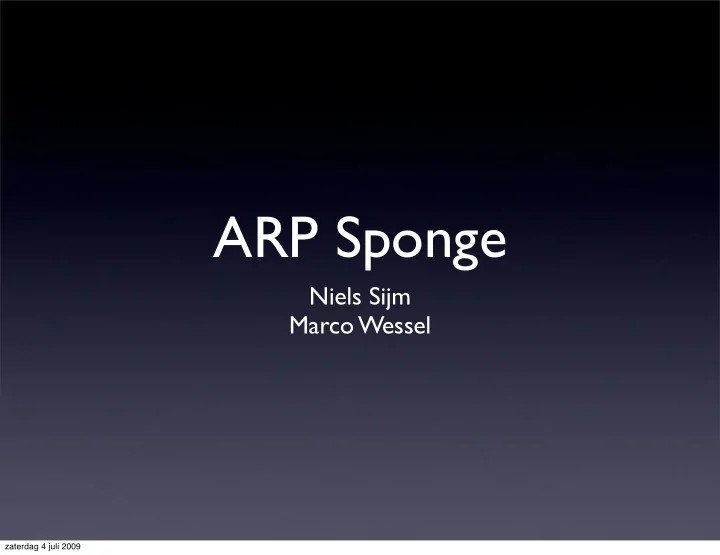

ARP Sponge Niels Sijm Marco Wessel zaterdag 4 juli 2009
AMS-IX? • One of the largest IXP in the world by members, ports and traffic • 317 Members, 580 ports, 675Gb/sec peak • All in one L2 subnet. zaterdag 4 juli 2009
AMS-IX Set-up • AMS-IXv3: • Big L2 subnet • Hub/spoke with backup network • VSRP for failover • No longer scalable. zaterdag 4 juli 2009
AMS-IX Set-up • AMS-IXv4 • MPLS/VPLS • One network, redundancy replaces failover • Still one big L2 subnet for customers zaterdag 4 juli 2009
ARP Sponge • ARP Sponge exists to decrease amount of ARP traffic on AMS-IX • Spoofs ARP replies when necessary zaterdag 4 juli 2009
Research Question What differences are there between IPv4 and IPv6 as relating to the sponge and infrastructure, and is an IPv6 implementation necessary? zaterdag 4 juli 2009
ARP Problems • ARP, needed for IPv4 over Ethernet • Resolves IP addresses into MAC addresses • Broadcast: ‘who is at this IP?’ • Must be processed by everyone who receives it • Too much ARP may cause CPU overload situations. zaterdag 4 juli 2009
ARP Sponge • Too much ARP happens when nodes are unavailable (down, nonexistent) • ARP requests are repeated (in case they were lost), often by multiple requestors • ARP Sponge exists to notice this and reply in downed node’s stead. • Nodes are ‘happy’, so far as their ARP caches go zaterdag 4 juli 2009
ARP Sponge • Start ‘sponging’ when too many requests are received in small amount of time • Stop ‘sponging’ when traffic is received from the real host • Gratuitous ARP, ARP request for other node, anything. zaterdag 4 juli 2009
ARP Sponge Benefits • Nearly ten-fold reduction of ARP traffic seen on an average day: • 1450 ARPs/min with • 13902 ARPs/min without • Additionally, allows AMS-IX to see traffic for nonexistent nodes • Notably, BGP sessions with routers that no longer exist zaterdag 4 juli 2009
IPv6 • Current Sponge only deals with IPv4 • What about IPv6? • IPv6 replaces ARP with ‘Neighbour Discovery’ • Part of ICMPv6 • Multicast instead of Broadcast • Also allows router discovery zaterdag 4 juli 2009
Issues for IPv6 Sponge • IPv6 subnet is 64 bits large • 18446744073709551616 (2 64 ) potential addresses • Sponge must keep state for IP addresses to determine when to sponge • ‘limited’ memory capacity not enough zaterdag 4 juli 2009
Issues for IPv6 Sponge • How to solve? • Use two lists: • White list of hosts known to exist (limited amount), filled by watching for traffic, can be seeded • Ring-buffer or timed-expiry for other addresses so old addresses expire automatically zaterdag 4 juli 2009
IPv6 ND • ND consists primarily of: • Neighbour Solicitations and Advertisements • Functionally equivalent to ARP • multicast on Ethernet, using solicited-node address • Router Solicitations and Advertisements. zaterdag 4 juli 2009
IPv6 ND • Solicited-node address: ff02::1:FFXX:XXXX • XX:XXXX replaced with last three octets of unicast address • IPv6 Multicast address maps to ethernet multicast address: 33:33:XX:XX:XX:XX • XX’es replaced with last 32 bits of multicast address zaterdag 4 juli 2009
IPv6 ND • Example: 2001:7b8:200:2202:216:cbff:fe90:fe41 • Solicited-node address: ff02::1:ff90:fe41 • Multicast Ethernet address: 33:33:ff:90:fe:41 zaterdag 4 juli 2009
IPv6 ND • This allows ‘selection at the gate’, or: don’t process irrelevant solicitations • MAC chips can be programmed for this • Keeps CPU utilization down in comparison to ARP zaterdag 4 juli 2009
Group overlap • Multicast group addressing scheme on AMS-IX: • addresses are structured as 2001:7f8:1::a5xx:xxxx:yyyy • AS-numbers that end in the same two digits ‘overlap’: 2001:7f8:1::a500:1200:0001 and 2001:7f8:1::a512:3400:0001 result in 33:33:ff:00:00:01 • Average of 2.21 nodes per group, maximum 6 zaterdag 4 juli 2009
Comparisons • Router CPU utilization ARP/ND, 10kpps ARP ARP ND ND ND host other host other group Juniper 5% 4% 100% 0% 69% Cisco 91% 55% 90% 55% 55% Linux 2% 1% 17% 0% 8% • Notes: • Juniper: FEB/FPC CPU; Cisco: main CPU • Cisco very busy handling packets in general, but nothing extra for irrelevant ND • Linux: used e1000 ethernet adapter which has ARP-offloading zaterdag 4 juli 2009
Switch comparisons ARP L2 ARP VPLS ND L2 ND VPLS 42% 63% 40% 62% • Tested 10kpps ARP/ND in L2 environment vs. VPLS • Small difference between ND/ARP: processing in switch • VPLS increases line-card processing load evenly between ARP/ND zaterdag 4 juli 2009
IPv6 Sponge Issue • 64-bit subnet means potentially very large neighbour cache for routers ‣ Attacker behind router starts ping sweep of peering subnet ‣ Router starts soliciting for neighbours (that don’t exist) ‣ ARP Sponge answers ‣ Neighbour cache fills up zaterdag 4 juli 2009
Recommendation • Given: • Multicasting of Neighbour Solicitations with ‘selection at the gate’ • Potential to fill up neighbour caches • We recommend not implementing IPv6 Sponge daemon (yet) • If implementing for other reasons: use small lists to prevent cache problem zaterdag 4 juli 2009
Thank you. Questions? zaterdag 4 juli 2009
Recommend
More recommend